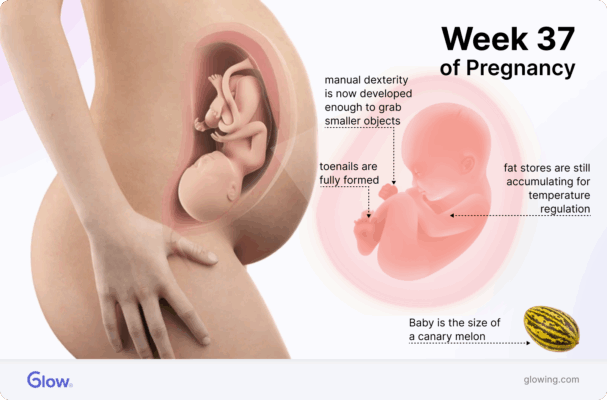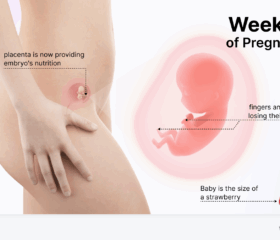Pregnancy Week by Week
37 Weeks Pregnant
Your baby is as big as a canary melon.
19.25
inches
6
pounds
37 Weeks Pregnant: Preparing for Your Baby’s Arrival
It’s possible to go into labor at this point, although if that happens, your baby will be considered “early term.”
It’s understandable if you’re feeling anxious about the chance that your baby could come at any minute—and even if that isn’t on your mind, you’re probably feeling a mix of emotions at the impending end of your pregnancy, anyway.
Read on to find out all you need to know about this stage and how to prepare for the big day.
Your baby’s development at 37 weeks
Again, your baby is almost ready to come out at 37 weeks. However, developmentally, there’s still a little ways to go.
For instance, while his major systems, such as his circulatory and skeletal systems, are fully formed, some of his organs, such as his lungs, are still maturing. 123
Here’s how your baby’s growth is coming along and what he’s up to in your belly:
- Size and weight: At this stage, your baby’s growing more fat, which will keep him warm after birth. He’s now around 19¼ inches long and weighs between 5½ and 6⅓ pounds (2.5–2.87 kg). 14
- Toenail growth: His toenails are fully formed. They’ll be flexible and soft at birth—you don’t have to worry about cutting them right after he comes out.
- Movement: You may feel less kicking and more stretching and wiggling from your baby due to the limited space in your womb. That said, if you don’t feel much (or any) movement, it could mean your baby’s in trouble, so see your doctor right away.
- Skills and reflexes: He’s busy practicing essential skills he’ll need for life outside your womb, such as blinking, breathing (which he simulates by inhaling and exhaling amniotic fluid), and sucking his thumb.
- Head engagement: If you see your baby’s head facing down in an ultrasound, the largest part of his head may have “engaged” with (i.e., entered) your pelvis. Engagement is most common around this time but may also come later.
If your baby is breech (meaning his bottom instead of his head is in the pelvis), your doctor may try to turn him or recommend a C-section.

Your body’s symptoms at 37 weeks
Like your baby, your body is also still changing. You may have the following pregnancy symptoms:
- Breast leaking: Your breasts may leak colostrum, the nutrient-rich first milk for your baby. This is more likely to happen when your nipples are stimulated, such as when you’re exercising or having sex. Use nursing pads if it bothers you. (Don’t worry if you’re not leaking; it doesn’t mean you won’t be able to breastfeed.)
- Vaginal discharge and spotting: There may be an increase in your pregnancy discharge or spotting, which should be clear, milky, or brown or pink (which means it’s slightly bloody, which is normal). You may also spot your mucus plug, which has been protecting your uterus. If you have heavy bleeding or foul-smelling discharge, call your doctor.
- Pelvic pain or pressure: This happens due to your baby dropping further into your pelvis. Consequently, you may need to pee more often.
- Digestive issues: Your baby’s growth may lead to bloating during your pregnancy, along with gas, constipation, and other digestive woes. Sometimes your poop may come out a lot thinner (a lower caliber) at this stage.
- Heartburn: Relatedly, as your baby pushes up on your stomach, you may start experiencing heartburn in these final weeks of pregnancy.
Other possible symptoms include backaches, leg cramps, swelling (especially in your breasts), “mommy brain” (forgetfulness), and pregnancy insomnia. You’re probably more than familiar with these from the previous few months.
You may also start to see more stretch marks on your belly and pregnancy-related varicose veins in your legs. If you’re concerned about your stretch marks, try moisturizing the area with hyaluronic acid, which may improve your skin’s appearance. 5
Watch out for the signs of HELLP syndrome
HELLP syndrome is a serious (and rare) pregnancy complication that affects your blood and liver. The name stands for “hemolysis, elevated liver enzymes, and low platelet count.” Common symptoms include fatigue, headache, fluid retention, rapid weight gain, nausea, pain in your abdomen, and blurry vision during pregnancy. If you have those symptoms and they feel stronger than you were expecting, tell your doctor.
What are the signs of labor?
Now that you’re approaching your calculated due date, it’s important to watch for the signs that your baby is coming.
Signs your labor is approaching (within a few days)
These signs of labor suggest that delivery isn’t far away:
- Mucus plug or bloody show: When you see mucus or “bloody show” (blood mixed with mucus) in your underwear or on your toilet paper, it may be a sign that your cervix is beginning to open (also known as cervical dilation), which means it won’t be long until your baby arrives. 6
- Nausea or diarrhea: As your body prepares for labor, you might experience diarrhea or nausea, like the return of the morning sickness you felt in the first trimester. 6
- Increased Braxton Hicks contractions: The “practice” contractions that you felt sporadically throughout your pregnancy will become more frequent and intense as your labor nears.
If you notice any of these signs, stay calm. You don’t actually need to do anything yet—just check that you’ve prepped your hospital bag with everything you need, and be ready to dash out when the big moment finally comes.
Signs your labor has already begun
Although your due date is still a few weeks away, there’s always the possibility of your baby arriving a bit early. If any of these signs crop up, your labor may have begun prematurely:
- Water breaking: This happens when your amniotic sac (the sac that encloses your baby) ruptures. When it does, you’ll experience a gush or trickle of fluid, which will be thinner than your usual discharge.
- Regular contractions: When you go into labor, your contractions will feel very intense, become more frequent, and last longer. Unlike Braxton Hicks contractions, they probably won’t subside when you change positions or rest. Try timing your contractions with a pregnancy tracker app to know if they’re the real deal.
- Back pain: Going into labor can also be accompanied by persistent or severe back pain. While some lower back pain is common during pregnancy, the pain you’ll feel going into labor may be more intense.
It’s definitely time to leave for the hospital when your water breaks or your contractions come every 5–10 minutes, with each lasting for 60–90 seconds. 6 When in doubt, call your doctor or midwife; they’ll help assess your situation.
What if your doctor has to induce labor?
If you’ve read up on childbirth, you’ve probably familiarized yourself with pregnancy induction—the medical term for your doctor helping your body go into labor if it doesn’t do it on its own, for some reason.
Induction via medication or mechanical intervention (e.g., a Foley bulb or balloon catheter) may be necessary if you have certain medical issues or if you’re more than 40 weeks pregnant. This is not as common, and not something you should worry about at this stage.
How to prepare for your baby’s arrival
Welcoming your baby home will hopefully be one of the best moments of your life, but getting everything prepped for that moment can be stressful. To ensure everything goes smoothly, follow these steps:
Get your home and nursery ready
A few weeks before labor, many expectant moms feel the urge to “nest.” Nesting during pregnancy can manifest differently from person to person. For instance, some women start madly organizing their shelves; others focus on tidying up the house.
This is a good time to finish setting up your baby’s nursery. Make sure that you have everything you need, including the crib, your baby’s clothes, and other baby gear. While you’re at it, practice actually using this gear so that it’s in your muscle memory when your baby comes home.
As you go about nesting, take care not to overwork yourself. Stay hydrated and take breaks.
Prepare for the hospital trip
As mentioned, you should prepare a bag that contains all the essentials you’ll need at the hospital beforehand. Stash it by the door so there’s no chance you’ll miss it in the shuffle.
Common items to pack in your hospital bag include:
- Photo ID, insurance plan, and hospital paperwork
- Birth plan (if you have one)
- Clothes (e.g., a bathrobe, nightgown, warm socks, and slippers)
- Toiletries like lip balm, body lotion, moisturizer, and other skin care products
- Comfortable pillows (if you prefer your own instead of the hospital’s)
- Eye mask and earplugs
- Glasses and contact lenses (if needed)
- Entertainment (a book, etc.)
- Heavy-duty maternity pads
- Postpartum underwear and bras
- Phone and charger
- Snacks and drinks
- Your baby’s clothes
- A receiving blanket
In addition, double-check that you properly installed your infant car seat so you can get your baby home safely. If you’re not sure, search for a nearby Child Car Seat Inspection Station (CCSIS) to have a certified technician check it.
Be aware of Meconium Aspiration Syndrome (MAS)
Here’s a fun topic to read up on: inside your womb, your baby is preparing for his first bowel movement. He’ll release a sticky, tar-like substance called meconium, typically within 48 hours of birth. To put it bluntly, this will be his first poop.
If your baby doesn’t have enough blood and oxygen (due to issues with your placenta or umbilical cord), he may pass meconium while he’s still in your uterus. If he inhales this back in, he could develop something called Meconium Aspiration Syndrome, which is characterized by trouble breathing.
This sounds scary, but doctors and nurses are trained to look out for MAS symptoms in newborns and act immediately if they spot it. MAS doesn’t strike very often, and it rarely leads to long-term complications. 7
There’s nothing you can do to prevent this; you should just be aware of it so you aren’t scared if it happens.
Be prepared for your baby’s hearing screening
The hospital will probably test your baby’s hearing before you take him home. If they didn’t, schedule an appointment for your baby within the first month of his birth. 8
If your baby fails his hearing test, don’t worry. This doesn’t necessarily mean he has hearing problems. It could also be that he was too active or the room was too noisy during the test. If this happens, the hospital will usually refer you to a pediatric audiologist to conduct a follow-up evaluation for your baby within the first 3 months of his life. 9
Like MAS, this isn’t something you actually have to do anything to prepare for; it’s just something to be aware of so you aren’t surprised a little further down the line.
Consider getting a postpartum doula
Some mothers hire a postpartum doula to help them transition smoothly into life with a newborn. While a doula isn’t qualified to give you medical advice, they can watch your baby for you, answer infant-related questions, and offer resources to help your body heal better.
Of course, hiring a doula is an added expense, and not everyone has the means for it. There’s no need to make a decision right now; many mothers don’t hire a doula until their baby is born.
Doula rates vary by city. Research the average rates in your area to get an idea of how much money you need to set aside if you want to hire one.
Check your maternity leave’s starting date and length
Your maternity leave’s starting date and length will depend on your employer’s policies, as well as your state’s laws and your own health (for instance, some moms with rougher pregnancies duck out of work a few weeks before even going into labor).
Under the Family and Medical Leave Act (FMLA), most companies with 50 or more employees must guarantee new moms 12 workweeks of unpaid, job-protected leave within one year of their birth. The catch is that you must have worked for your employer for at least a year and over 1,250 hours in the past 12 months to be eligible. 10
Ask your HR about your company’s policies. Chances are that you qualify for the FMLA, and your company might even offer some amount of paid maternity leave.
Tips for staying comfortable and healthy
Getting everything ready for your baby’s arrival can be overwhelming. Double check that you’re:
- Staying hydrated
- Getting enough rest
- Eating well
- Doing light exercise (unless your doctor says otherwise)
When it comes to staying active, stick to low-impact exercise like walking or swimming. You can also get a prenatal massage to relieve your tense muscles and sore spots.
Final thoughts
Reaching this stage of your pregnancy is no easy feat, and you should be proud of yourself. As you prepare to welcome your baby into the world, take a deep breath and trust your body—it knows what it’s doing.
It’s great to stay informed (just like you’re doing right now by reading this article), but now’s also the time to get excited. It won’t be long until you have a giggling newborn in your arms!
Article Sources
- MedlinePlus. "Fetal development" Retrieved June 26, 2025.
- Eunice Kennedy Shriver National Institute of Child Health and Human Development. "Preterm Labor and Birth" Retrieved June 26, 2025.
- American College of Obstetricians and Gynecologists. "Avoidance of Nonmedically Indicated Early-Term Deliveries and Associated Neonatal Morbidities" Retrieved June 26, 2025.
- Alabama Cooperative Extension System. "Moms to Be: From Seed to Melon" Retrieved June 26, 2025.
- Cleveland Clinic. "Hyaluronic Acid" Retrieved June 26, 2025.
- MedlinePlus. "Am I in labor?" Retrieved June 26, 2025.
- Cleveland Clinic. "Meconium Aspiration Syndrome" Retrieved June 26, 2025.
- National Institute on Deafness and Other Communication Disorders. "Your Baby's Hearing Screening and Next Steps" Retrieved June 26, 2025.
- Commonwealth of Pennsylvania. "Newborn Hearing Screening and Intervention Information for Families" Retrieved June 26, 2025.
- U.S. Department of Labor. "Family and Medical Leave (FMLA)" Retrieved June 26, 2025.







